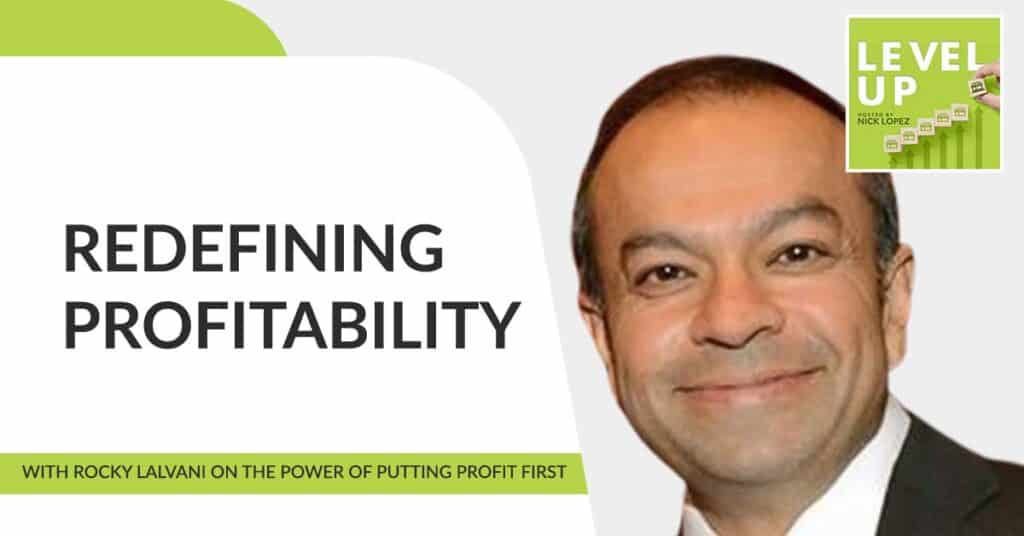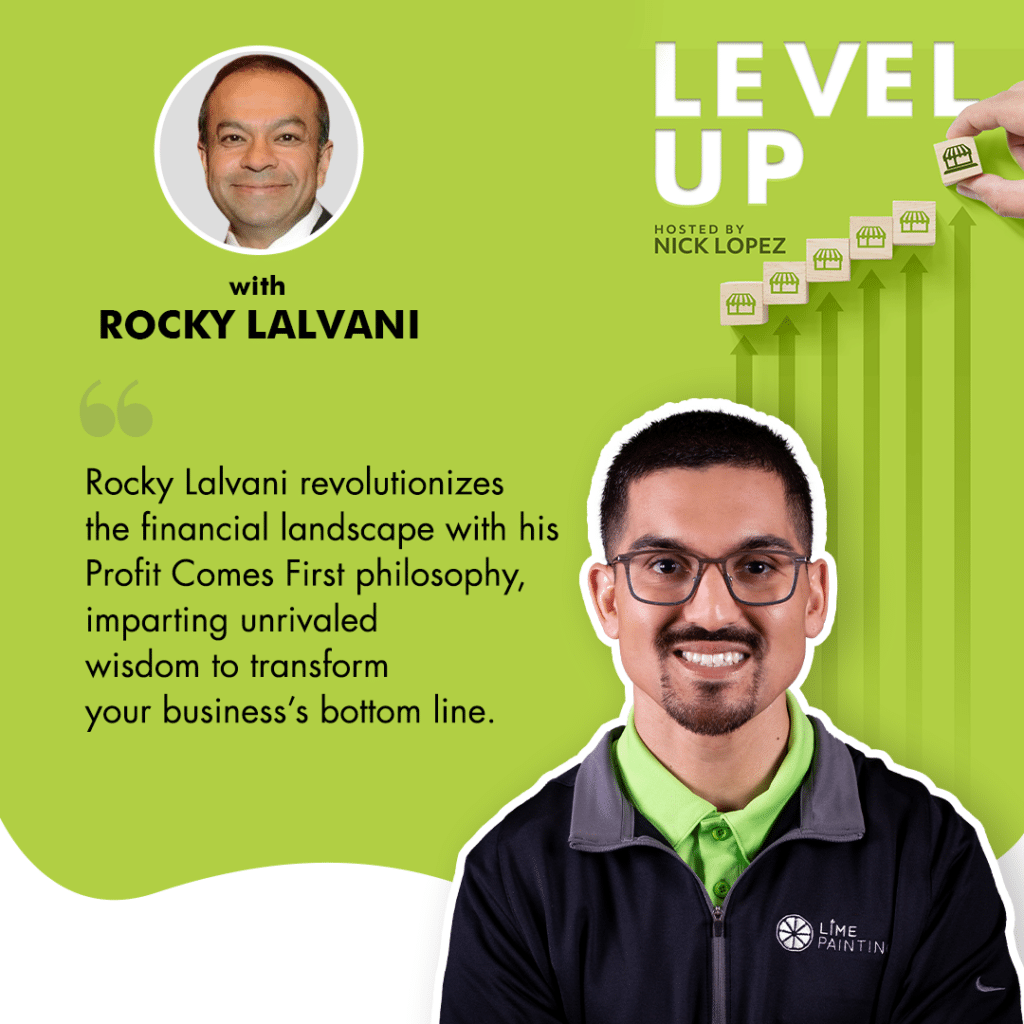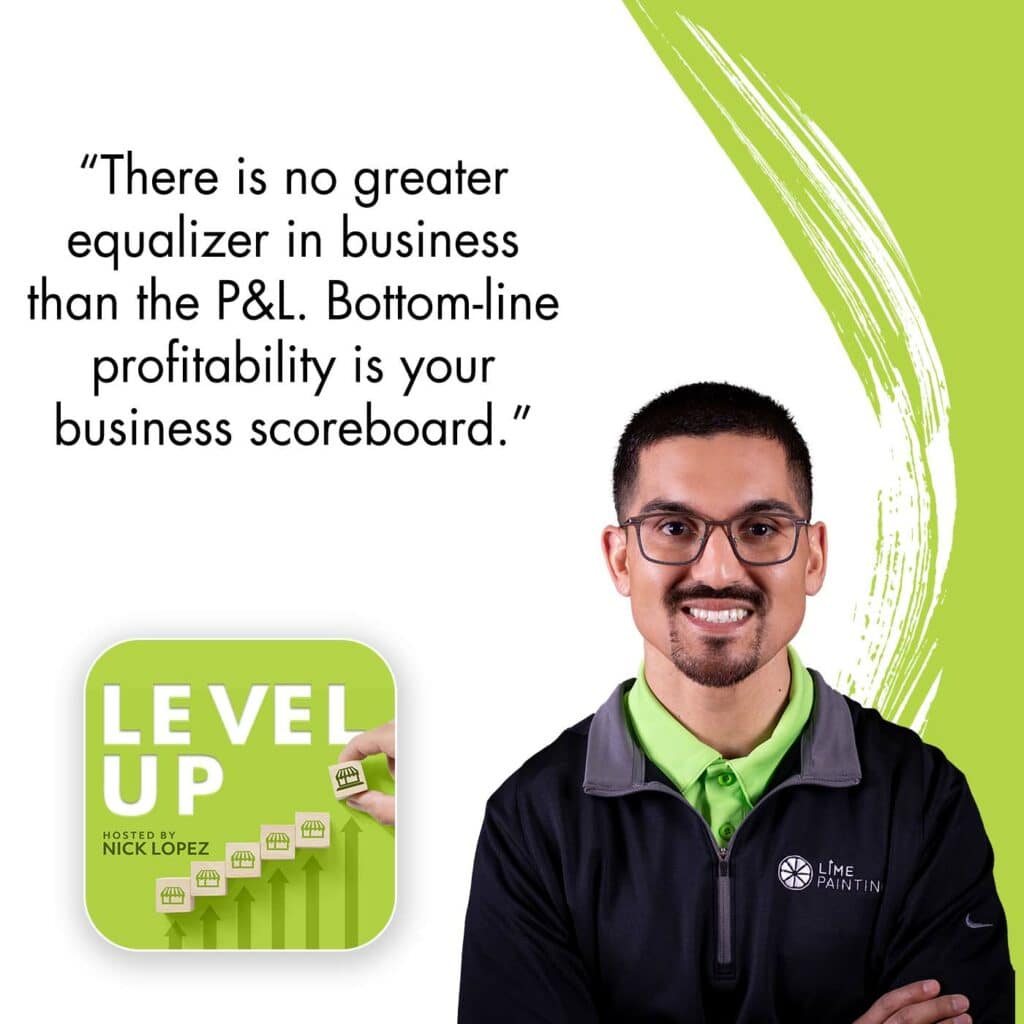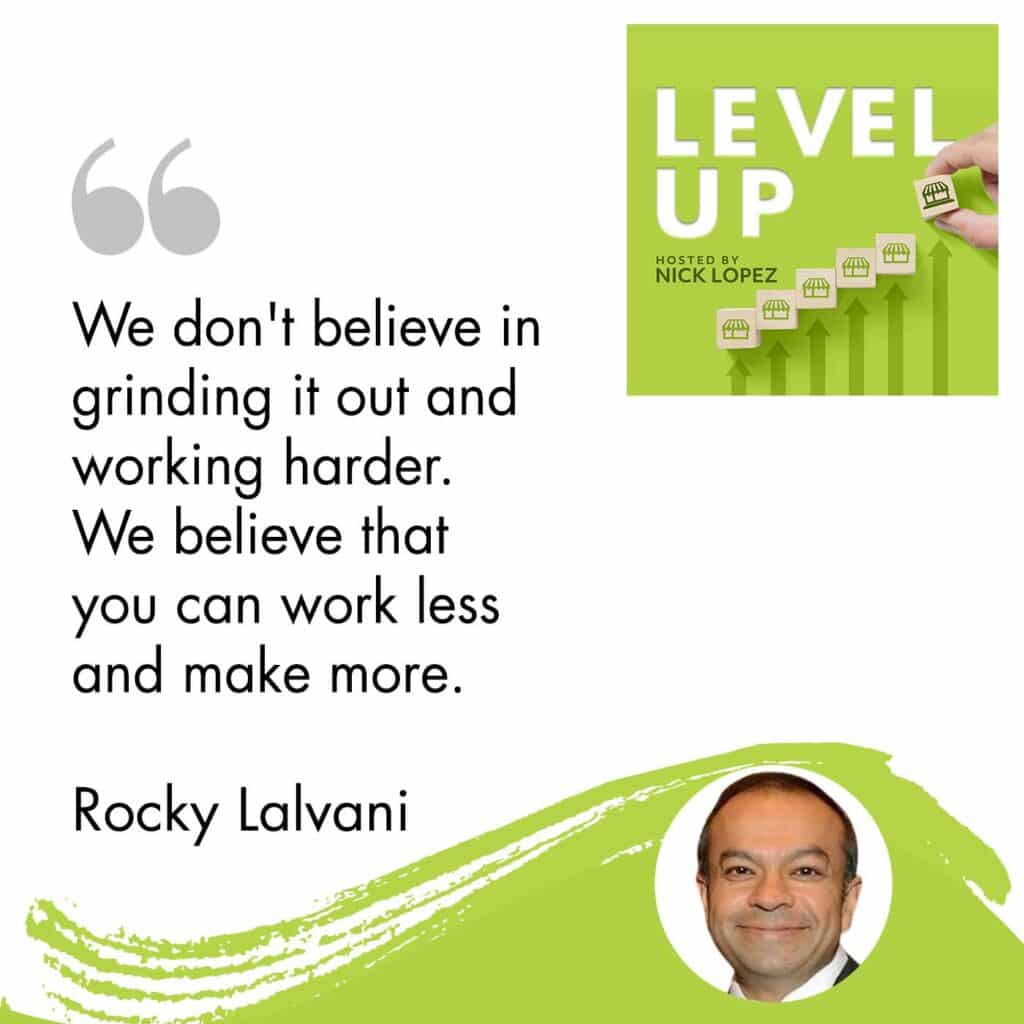
Whether you’re seeking to revamp your financial framework or build a robust financial team, this episode is a treasure trove of invaluable wisdom you won’t want to miss. In this transformative conversation at the Level Up Show, we’re honored to feature Rocky Lalvani, the mastermind behind the groundbreaking Profit Comes First philosophy. Rocky unveils the core motivations propelling his business approach, emphasizing the significance of flipping the traditional profit equation to ensure financial success from the start. Through his insights, listeners will gain a comprehensive understanding of how his system outperforms conventional financial strategies by prioritizing profitability, thus securing a stable foundation for any business. Moreover, Rocky shares his expert advice on assembling the ultimate financial team, covering the essentials in finding the best controller, bookkeeper, CFO, or accountant. His tips are designed to help organizations navigate the complex world of finance with confidence and precision. Additionally, the conversation delves into the crucial KPIs that signify business success, offering listeners a clear roadmap to achieve and exceed their financial goals. Join us as Rocky distills his vast knowledge and experience into practical strategies that promise to elevate your business!
—
Watch the episode here
Listen to the podcast here
Redefining Profitability: Rocky Lalvani On The Power Of Putting Profit First
Unlocking Financial Success With Key Strategies, Performance Indicators, And Building The Ultimate Financial Team
In this episode, we most certainly have an incredible guest, Rocky Lalvani, the Founder of Profit Comes First. Welcome to the show.
Thank you so much for having me. It’s great to be with you.
Business and the scoreboard. There is no greater equalizer in business than the P&L, bottom line, and profitability. It is your business scoreboard, most certainly. How did you go about starting this incredible organization?
My company is Profit Comes First. The book is Profit First. That’s Mike Michalowicz’s book. I started it because I was in the personal finance space for a while. I had learned the principles of building wealth as a kid. I built my wealth as a W2 employee, and then I was like, “What do I want to do? Working for a company is nice, but it’s not my gig.” I was like, “I’m going to teach people how to build their own wealth.” What I’ve learned through that process is people want to learn how to get rich quickly. Nobody wants to learn how to get rich slowly. The chances of you getting rich quickly are about 1 in 2 billion. The chances of you getting rich slowly are 1 in 1 if you do it.
The problem is nobody wants to do the one-to-one chance. They all want to do the 1 to the billion chance. Throughout this whole process, I came to this learning that business owners weren’t looking at their financials. I was like, “How do you run a business and not understand the business-to-business in your reports?” It turns out that business owners are people who went into business to do what they loved not a single one of them or at least most of them didn’t like accounting. They ignored their numbers. They just went out and did what they loved, which is fine, except when you struggle with your profitability when you don’t know what the scoreboard says, when you’re running a business blind on the financial side and wondering why you’re struggling so much.

Having a competency around what drives your business.
If you’re going to be in business, you’re going to have to understand the business of business. Either you’re going to be lucky or struggle. It’s one or the other the statistics say that most businesses don’t make it five years. Very few get to 10 years, and hardly any get to 7 figures. The reality is if you understand the business of business, and you figure out how to do it, your chances of success go up dramatically. That’s what we do. We try and help people to ensure that they’re going to be successful.
The Profit First System
What is the Profit First System?
It is something developed by Mike Michalowicz. If you haven’t read Mike’s book, I encourage you all to read Mike’s books. He’s an entrepreneur. He’s a business guy who talks business like a business guy, not a business guy who talks business like an academic. Mike owned a forensic data company. They investigated Enron, high profile divorces and they were looking for, “Let’s go find where the money disappeared.” He did well. He sold his business and walked away with his payday. Within a couple of years, he thought he was a smart business guy. He lost it all to the point that they came for the keys to the house in the car. Nobody wants to be there.

He went through that kind of downturn. Through that time, he started thinking, “How do they get it wrong? How do we prevent this?” Through that, he came up with the realization that the accountant gave us the wrong formula for profit. We’re told sales minus profit or sales minus expenses equals profit, which makes profit a leftover afterthought, a result of things that you don’t have control over.
He said, “No wonder this is a struggle. We’re supposed to be profitable, pay ourselves first, and ensure that, why don’t we change the equation?” He changed the equation to sales minus profit equals expenses. That little shift is a mindset shift. He built a cashflow system that works the way business owners work, which is basically to look at their bank balances and make choices based on their bank balances. He took the habits and leveraged them to their advantage. That’s basically what he talks about in the book.
After writing the book, we found people still struggle to implement it. He’s got a whole bunch of people like me who are certified to help people implement the system. That’s the first step we do. That’s our basics then on top of that, we’ve layered around much more to take people to have a growing and a much more profitable business. You work less. We don’t believe in grinding it out and working harder. We believe you can work less and make more.

How do you do that?
First, you have to look at your business and say, “What is the math behind the business?” All businesses follow the same similar math setup. Let’s talk about it. I’m going to make this simple. Please don’t tune out because they said the word math. Everyone’s got to drive revenue. You need sales. That’s understandable. How do you get to your sales? Your sales are how many sales you may times how much your average sale is. We know that. If I say $1,000 is my average sale and I have 100 sales, I’ve made $100,000.
How do I make 100 sales? I need leads. How many leads did you get? Maybe you got 1,000 leads, a 10% close rate, which created your 100 sales at $1,000. Now, we got to $1,000. That’s the basics of revenue generation. Behind each of those numbers, there could be 100 other things that go on. Behind lead generation is, “I had 1000 leads, 100 were Facebook, 100 were YouTube, 100 were postcards and 100 were phone calls,” then we start looking, “Which ones work better than others? Where should we be spending our time and efforts? Where should we put money behind our marketing to get more people to show up?”
We look at our conversion rate, “Do all my salespeople convert at the same rate? Do some do better than others? What makes this one or this channel better than that? How do we now start to systematize this across everybody?” Let’s face it, if I could simply take you from a 10% to a 20% conversion rate, you would double your sales without spending any more money, just by learning that process. Maybe $100 is too cheap. Maybe we should be charging $200. We doubled your sales by charging the appropriate price. Too many business owners underprice their products. They don’t understand the value of what they deliver. That’s the whole revenue generation side. Once you make revenue, it costs money going?
Where is all your money going? Is the amount of money going out the door appropriate for your business model and for what it is in? At the end of the day, is there enough money left for you to pay yourself and make a profit? That’s the question. That’s your P&L. That’s where that comes from. In the last part, people say to me, “My P&L said I was profitable. My accountant told me on taxes, I was profitable. I have no cash. Where’d my cash go?” We look at the last part of the equation. Where did the cash disappear? Cash disappears to inventory and accounts receivable, somebody bought something, and you delivered it, but you didn’t collect.
There is some cash out there you thought you had the sale, but there was no cash. It could disappear because you treat your business like a piggy bank and you’ve been paying for stuff because it’s tax deductions or whatever and cash is disappearing. Maybe you have debt payments. If you have debt payments, they don’t show up necessarily on your P&L. While you might be profitable, you may not have cash, and that’s the last part of the equation. All of this stuff is pretty standard, but then we go in and we tweak it because each business is a little bit different in how it works for your business. Once we see the whole thing, we can go, “If you made this little bitty change over here, you could make your profits go up 50%. Are you willing to make that change? Are you willing to make a small choice to make twice as much money? That’s a choice you’ll have to make.”
Clearly, you have to understand the story that the financial statements tell.
I don’t think most people understand them. I think the other problem is most accountants look at your financial statements as what occurred. Here’s the thing. Most business owners, by the time they find out what occurred, don’t care, “I want to know what to do tomorrow.” That’s where the financial statements for a lot of business owners are far behind very irrelevant. What we do is we figure it out going forward and work backward to say, “What do I need today so that tomorrow, I have a growing and more profitable business?”
Controller, Bookkeeper, Accountant, CFO
Look at a controller, a bookkeeper, a CFO, and an accountant. If you’re an organization that is growing and has access to one of each of those, and that’s the appropriate size for that entity, as the business owner, how do you leverage those four professionals?
The first thing is to understand that each of these four professionals has a very different skillset, a very different desired outcome, and a very different lens and how they look at your business. Let’s walk through them all. The lens of the bookkeeper is, “I have all these transactions from everywhere. I need to classify them in a systematic way.” That’s what a bookkeeper does, they make sure that your accounting system is classifying all of the incoming transactions appropriately. That’s their goal. Don’t ask them to figure out whether you’re profitable, maybe some of them can do it because they look at the report. In most of them, that’s their skillset. your controller, their job is to make sure that there is a good system in place so that the bookkeeper is getting the right information at the right time and that everything is flowing to where it belongs to go through because you might be getting information from ten different places.
Their job is to make sure that there are fraud controls in place and the actual processes of how you build out in how you collect, then how it gets to the bank, that all of those processes are in the right place that they’re working and communicating. All of that is being done. They are not strategy people. They are more systematic. They build the machine for the business. They keep the machine running, then the bookkeeper is taking the data and doing the work on the machine.
You talked about an accountant. Most accountants or tax people, all they care about is filling out the tax return correctly to report to the IRS because they have to sign your tax return so they want to make sure that they feel comfortable that this accurately reflects your business. Their job is not to make you profitable or grow. It’s to record what happened last year, compliant with what the IRS wants, in a way the IRS wants it. The IRS might tax you based on their rules, but their rules have nothing to do with your cash flow. You could have no money in the bank $100,000 in taxes. That happens all the time. The CFOs job is strategy. They should be looking at all those different components, making sure that they’re correct and working, but then their job is to take that information and turn it into a forward-looking strategy.
Now not all CFOs do this, but that is what they should do depending on their background, their training and how they look at things. People who come from an accounting background have an accounting perspective. People who come from a business and entrepreneurial background have an entrepreneurial view of the numbers. I come from an entrepreneurial background. I’ll take all the data from everybody. I want to know how to take that data and turn it into actionable steps that we can take that are easy and quick to increase your profit and grow your business.
KPIs That Make Sense
I’m sure every business is different. When you start looking at KPIs, you’re talking a lot about budgeting and forecasting, there have to be financial KPIs ratios that are reported in this process so that you can proactively double down on what grows the business. Simply put, right, what are some KPIs? Could you talk to us about your approach with KPIs?
What we do is we look at each business because each business is different. You could have two businesses in the same industry that have two totally different business models. What we do is figure out what are the KPIs that make sense for this business that matter and that we can make a difference with. Some basic examples. For some businesses, it’s about lead flow. For some businesses, it might be the conversion rates. For some businesses, it might be client retention. For some businesses, it could be the gross profit margin, and making sure that they’re doing that. The gross profit margin then drives the pricing. it could be all of those things, the number of transactions and sales.
Many different KPIs are all important, but some in each business have their own handful that are truly the drivers of that business because, in some businesses, you don’t have control over a KPI. In other words, if I’m going to put something on Amazon and sell it, I can’t control how many people show up at Amazon looking for what I’m selling. It doesn’t matter. That’s irrelevant to me. That’s the thing, whereas if it’s my own website, now, all of a sudden, how many people show up at my website is important. It’s understanding those differences, and figuring out what’s most important for that business in that business owner.
Can you speak to an industry and some simple ratios, KPIs, and benchmarks? I don’t know them off the top of my head because there are many interest trees and many things, but I’ll give you a couple of things off the top. How many of your potential leads turn into clients? If it’s less than 50%, there’s a problem there. Either you’re reaching the wrong people, you’ve got the wrong message, you’re out of sync price-wise, something’s not right. If you can’t convert half your leads, you have to ask yourself, “Is this industry constrained where that’s the norm or am I not doing a good job on the sales cycle?”
The other one is gross profit, you end up with a gross profit margin of less than 30%. You’re almost destined for failure unless you can drive massive amounts of revenue. That’s your business model. I think that’s the other big one that we look at. The last one is profit, if you’ve got a profit margin of less than 10%, one bad month, and you’re in trouble. Those are probably some of the top-line ones and some ways to look at it. It’s looking at everything. Here’s the thing. Everyone wants to know, “What’s the benchmark for my industry?”
I’m going to tell you something. The benchmark is average. We don’t work with average people. If you want to be average, we’ll do what average does. I’m not interested. The question is, how do we blow out every benchmark? How do we reinvent the business to do things dramatically differently so that nobody can touch us?
Moving The Needle
How do you begin helping a client realize that?
How do they realize it or how do we take their data and turn it into a story? Those are two different things. If you don’t know you’re in trouble. I don’t know what to tell you. There are business owners who don’t want to deal with the money and don’t want to deal with it. I’m not going to talk to them, “Have a great time. Enjoy your business. We’re not a good fit.” If you are somebody who wants help, then what we do is look at their current systems. We look at all of these different data points, then we start to build for them a custom dashboard and scoreboard that makes sense for their business, and then we take baby steps from where they are to where they need to be. It takes time to bring about the changes that we talked about. It might be 2 or 3 years. This is not an overnight success.
Most entrepreneurs don’t want to hear that.
I’m not a good fit for them, and I’m okay with that.
That’s because you need to move the shit.
People have a variety of different reasons for going into business. Some people want to get better. The biggest surprising learning that I had was how many people don’t want to do the work to improve. I’m like, “I can’t do anything about that. I’m not going to beat my head anymore.”
You have your top 20, your middle 60, or your bottom 20.
We believe that you should be in the top 20, if not higher, let everything else go because most of the things below the top 20 are unprofitable. While they might bring in cash, there’s a good chance that they are an anchor on your business.
What is an anchor?
The people, especially the bottom 20% are definitely an anchor, that middle 60% might be an anchor and a slow drag, but there’s a good chance that they’re not helping you to move forward. You’re in the grind. You’re hustling and wondering why you don’t see a lot of return.
Business owners have that same equation as well. You have the top 20% of owners, the middle 60 bottom 20 profitable owners are probably the top 50%. Is it less or top third?
What percent of businesses don’t make it five years? There’s your top 20 and if you go out to 10 years, the numbers are even worse.
Eighty percent of those don’t make it.
You got to play in the top percentage points. Everyone else wasting time.
Would you say that you’re already in the top percentile just by looking at your numbers and knowing them?
If you go into the Profit First book, and you read it, Mike says 80% of business owners don’t even have financials looking at them.
We’re seeing some correlation here.
Out of the 20% that is left, three-quarters of them look at their numbers but don’t know what to do. 5% look at their numbers and know what to do. That’s why the 10-year survival rate for businesses is about 5%. Surprising, isn’t it? That’s what it comes down to. You understand your numbers and you understand the language of business. Chances are, you will survive.
You’re going to double down. You’re going to clamp on to those profit generators versus running around busy with too many no direction.
Too many people run around busy.
The great equalizer and an objective scoreboard.
I imagine they held the Super Bowl. There was no scoreboard. No lines on the field. No game clock. You think anyone is watching the Superbowl? No. I hope you’re not running your business that way.
I always love talking about conversions, and sales and getting better at this metric. I always love, from a sales perspective, speaking of football analogies, it’d be silly for the quarterback and the receiver to say, “We’re going to have an all-time year. We’re going to go sixteen this year, and we’re going to win the Super Bowl. We’re not going to practice we’re going to show up and compete on game day.” In sales, you have to roleplay you have to study your scripts. You have to know your rebuttals. You have to understand your solutions and be consistent about your sales process. It is much like running around. On a football team, you’re going to know precisely how many yards and when you turn, and that receiver is going to have this innate chemistry, where the receiver turns around and the ball is there. That is the byproduct of repetition, and that’s not sexy. Looking at the numbers is not sexy. It’s not fun.
It is for me. I like to look at his cash in the bank.
Of course, but only 5% get to.
That’s your choice. We all have a choice.
What I’m saying is that 5% is good at the X’s and O’s, the things that are not sexy. It’s creating the ratios, doing the work to understand your books, and the levers within them, then the consistency to be proactive about driving them and tying them to operational SOPs that funnel toward those levers that help you be in business for many years and give a lot of value. It’s incredible. I think everywhere in life that you look, whether it’s the classrooms growing up as a student, the football teams that we’re talking about, or whatever organization in any industry, you have those top 5% of folks.
Clearly, you are providing a path for the top 5% of performers. It would be incredible work to your point and exciting work, but you have to do the non-sexy work for it to be exciting. That can take four years. That can be the long game versus instant gratification, “I turned on the lights of the business. It should be print money.” You’ve certainly inspired me. I appreciate you coming on in sharing. You’ve been at this for how many years?
We started the business a few years ago.
In finance, we are looking at spreadsheets.
My whole life. That goes back to being a teenager. It’s been there a long time. It’s what I love doing. They tell me stories.
What is your superhuman power?
Literally, a lot of people will look at numbers, and they just see a block of data that they can’t tell. I have this ability to look at numbers and see what’s happening inside of them, where the differences are, where things don’t look right, and then figure out the story behind the numbers and being able to then just pinpoint that out and hone in on where the issues are.
LIME stands for Love, Integrity, Mission, and Excellence. I have to ask you, what is your favorite value and why?
I don’t know how people pick between these. That to me makes no sense. You have to figure out how they all go together for you, and how to make sure that you are honoring each and every one of them.
Our team and folks at LIME often joke, “Which does this go around?” because it depends on what season you’re in. It’s fun to do business a certain way. Clearly, you have been serving folks for a long time. If anyone would like to get in touch with you, how can they do that?
My website is Profit Comes First. From there, you can find the podcast where we share everything we do for our clients, a tremendous amount of success stories and ideas for you to have a growing and more profitable business. That’s all at ProfitComesFirst.com.
You heard it from Rocky, based in Pennsylvania and doing some incredible work. If you’ve enjoyed this episode, please subscribe to the channel. It’s how we’re able to continue to grow to bring on talented individuals like Rocky to help us all level up. Hit the like button, drop a comment, and as always, level up.
Important Links
About Rocky Lalvani

Rocky Lalvani is the Profit Answer Man. He teaches them how to ensure they get paid and make profit a priority! As a certified Profit First Professional, he implements Mike Michalowicz’s Profit First System. We change the accounting formula of Sales – Expenses = Profit to Sales – Profit = Expenses. This ensures Profit comes first! (PS.
It’s not about money at all costs, people come before money!) Rocky started with nothing when his parents immigrated to the United States when he was two years old, and his parents were in their 40’s. It was his parents’ second time starting over in life as they moved here to experience the American dream. In spite of a lot of struggles and his mom passing away when Rocky was 7, he has been able to achieve financial and life success. Rocky loves to share his journey and inspire others to achieve their dreams even faster.
Rocky Lalvani is the Profit Answer Man. He teaches them how to ensure they get paid and make profit a priority! As a certified Profit First Professional, he implements Mike Michalowicz’s Profit First System. We change the accounting formula of Sales – Expenses = Profit to Sales – Profit = Expenses. This ensures Profit comes first! (PS. It’s not about money at all costs, people come before money!)
Rocky started with nothing when his parents immigrated to the United States when he was two years old, and his parents were in their 40’s. It was his parents’ second time starting over in life as they moved here to experience the American dream. In spite of a lot of struggles and his mom passing away when Rocky was 7, he has been able to achieve financial and life success. Rocky loves to share his journey and inspire others to achieve their dreams even faster.
